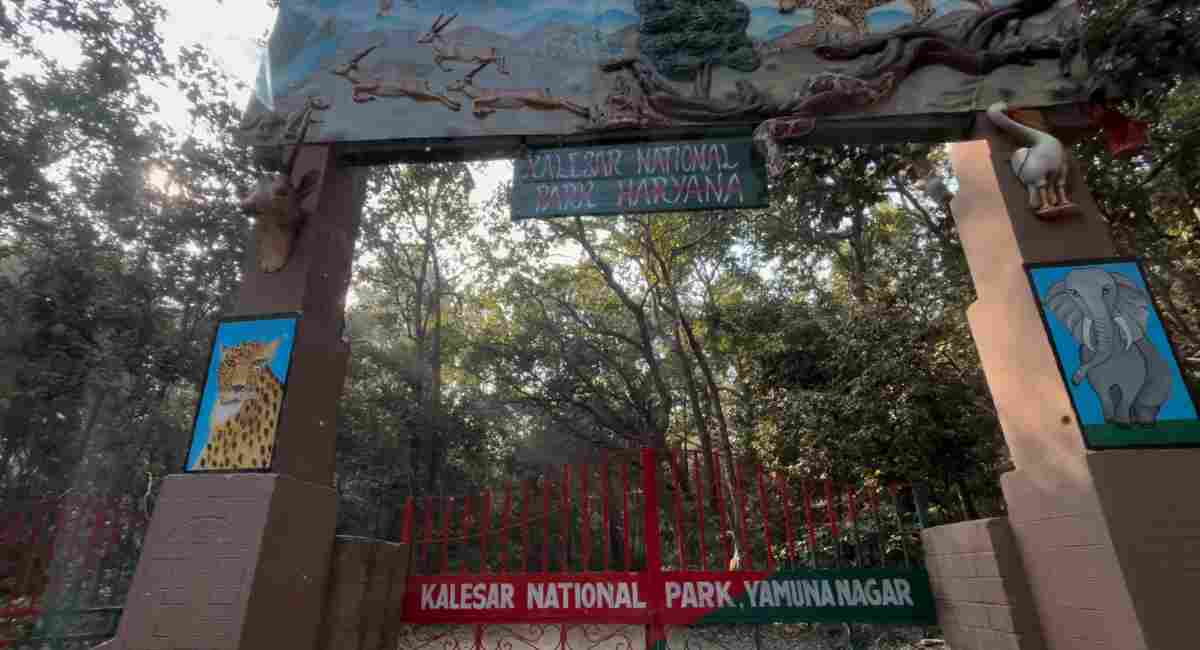Haryana National Parks
In Haryana there are two National Park one is located in the smart city of Harayana Gurgaon in Sultanpur and another is in the foot of Shivalik ranges in Yamunanagar district.
-
Kalesar National Park–
Kalesar National Park is nestled in the heart of Shivalik Hills. Kalesar National Park is located in the Yamunanagar district of Harayana sharing boundary with three States viz., Himachal Pradesh, Uttranchal & U.P. Kalesar National Park covers a very large area of 46 square kilometers. Diverse range of flora and fauna in Kalesar National park is a heaven for wildlife enthusiasts.
Kalesar National Park named after the Kalesar(Shiva a Hindu God) temple. The area is full of bio-diversity and dense sal trees covering the whole area.
How to Visit
You can hire a Safari easliy to visit Kalesar National Park. Wildlife Wing of Forest Department gives permission to locals for this perpose and you can contact these locals through Wildlife Inspector, stationed at Kalesar National Park. Charges are payable to car owner only. Safari covers almost 15kilometers in a single ride.

Safari Prices
Safari prices may approximately ₹1000 rupees for one safari for a single ride of Kalesar National Park.
Safari Routes
There are 3 safari routes have been delineated in the National Park.
-
Route No. I. 20 feet wide motorable road with length of 7.0 kms.
-
Route No. II. 60 feet wide motorable road with length of 6.5 kms.
-
Route No. III. 60 feet wide motorable road with length of 6.0 kms.
Timmings to Visit National Park
The best time to vist Kalesar National Park is in the month of November to December and July to September.
-
Winter Months – 7:00am to 10:00am and 3:30pm to 6:00pm.
-
Summer Months – 6:00am to 10:00am and 4:00pm to 7:00pm.

For Birdwatchers
If you love bird watching then Kalesar National Park is the best place for you. This park have very wide variety of birds species with both local and migratory birds. When you visit this park you experience the beautiful chirping of birds in the every corner of national park. Birdwatchers can spend hours and hours in this beautiful place exploring the park’s different habitats. It’s a very delightful experience for nature lovers.
These are some species that has more chances you see them during your visit.
-
Peafowl (Indian Peafowl)
-
Jungle fowl (Red Junglefowl)
-
Partridges (Grey Francolin, Black Francolin)
-
Bulbuls (Red-vented Bulbul, White-eared Bulbul)
-
Woodpeckers (Fulvous-breasted Woodpecker, Rufous Woodpecker)
-
Drongos (Black Drongo, White-bellied Drongo)
-
Barbets (Coppersmith Barbet, Brown-headed Barbet)
-
Treepies (Rufous Treepie, Grey Treepie)
-
Babblers (Jungle Babbler, Yellow-billed Babbler)
-
Flycatchers (Asian Paradise Flycatcher, Tickell’s Blue Flycatcher)
Wildlife
When you visit the National park through safari you may encounters fascinating creatures like leopards, elephants, sambar deer, barking deer, wild boars, langurs. This park untouched wildlife environment provide a safe home to these animals, allowing them to thrive in their natural habitat.
These are some animal species you may see in Kalesar National park during your visit.
-
Leopards
-
Elephants
-
Sambar deer
-
Barking deer
-
Wild boars
-
Langurs
-
Indian porcupines
-
Indian crested porcupines
-
Indian pangolins
-
Himalayan palm civets
-
Indian muntjacs (barking deer)
-
Indian gray mongoose
-
Indian jackals
-
Indian wild dogs (dholes)
-
Indian porcupines
-
Himalayan black bears
-
Indian crested porcupines
-
Indian civets
-
Rhesus macaques
-
Himalayan palm civets
Conclusion
You must visit this place if you are a nature lover and loves to spend your time in natural habitat. Explore wildlife of Kalesar National Park. In summary, Kalesar National Park in Haryana perfect example of biodiversity and natural splendor. Its dense forests of sal trees are a diverse array of wildlife, offering an amazing experience for nature enthusiasts. From leopards to langurs, the park’s vibrant ecosystem captivates visitors, underscoring its significance as a vital sanctuary for India’s precious wildlife.
Contact Details
If you wish to visit this beautiful place then contact on this number and get all information.
Phone: 094678 59568
-
Sultanpur National Park
Sultanpur National Park is located in Gurugaon city of Harayana, approximately 46 kilometers from Delhi and 15 kilometers from Gurugaon which is easily accessible for both the cities. It is a heaven for nature enthusiasts and birdwatchers. It’s a very popular place among the people for their holiday day trips. It is very liked places for photographers and nature lover.
Sultanpur National park covers a area of 1.43 square kilometers.

Facilities for Visitors
-
There is parking and toilet facilities for the tourists.
-
Educational Interpretation are setup for giving proper guidance to the tourists.
-
Tourist complex which has all modern facilities like restaurants and bar ,etc.
-
There are also facilities for picnicking and nature walks.
For Bird watchers
Bird watching is the primary activity in Sultanpur National park. These are some commonly sighted species in this park Painted Stork, Common Hoopoe, Purple Sunbird, and Black-winged Stilt.
Their are special 4 special towers(machans) in the different locations in the park for bird watchers. You get the amazing view of park from here and enjoy the peaceful environment.
History
Initially Sultanpur National park is created as a bird sanctuary in 1972, but later it is designated as National Park in 1991. It is established for conserving the rich biodiversity of the region, specialy for the avian species, particularly migratory birds.
Flaura and Fauna
This park is home of very large diverse range flora and fauna. Main attraction of this park is its bird population, with over 250 species. It features lush greenery, including grasslands, woodlands, and wetlands. In winters it became sanctuary for migratory birds.
Some Animal and birds species which are found in Sultanpur National park
Bird Speciesand Scintific names |
Animal Speciesand Scintific names |
|
|



